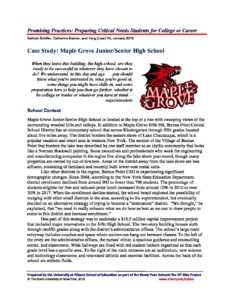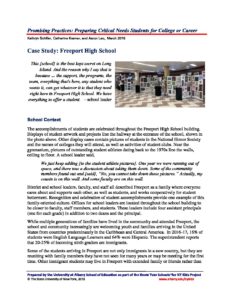Publication Year: 2018
Findings from seven secondary schools beating the odds at graduating and preparing students for college and career.
In 2017-18, research teams investigated 10 high schools regarding the preparation of critical needs students for college and career. Three of these schools were typically-performing (with graduation rates as predicted for the student population served) and the remainder were odds-beating schools (with graduation rates above predicted for the student population served). This cross-case report describes the four themes observed across all odds-beating secondary schools.
In 2017-18, research teams investigated 10 high schools regarding the preparation of critical needs students for college and career. Three of these schools were typically performing (with graduation rates as predicted for the student population served) and the remainder were odds-beating schools (with graduation rates above-predicted for the student population served). This reports describes the methods and procedures for the study.
This case study is one of 10 case studies examining preparation of critical needs students college and career.
This case study is one of a series of studies conducted by Know Your Schools~for NY Kids since 2005. In 2017-18, research teams investigated 10 high schools regarding the preparation of critical needs students for college and career. Three of these schools were typically-performing (with graduation rates as predicted for the student population served) and the remainder were odds-beating schools (with graduation rates above-predicted for the student population served).
This case study is one of 10 case studies examining preparation of critical needs students college and career.
This case study is one of a series of studies conducted by Know Your Schools~for NY Kids since 2005. In 2017-18, research teams investigated 10 high schools regarding the preparation of critical needs students for college and career. Three of these schools were typically-performing (with graduation rates as predicted for the student population served) and the remainder were odds-beating schools (with graduation rates above-predicted for the student population served).
This case study is one of 10 case studies examining preparation of critical needs students college and career.
This case study is one of a series of studies conducted by Know Your Schools~for NY Kids since 2005. In 2017-18, research teams investigated 10 high schools regarding the preparation of critical needs students for college and career. Three of these schools were typically-performing (with graduation rates as predicted for the student population served) and the remainder were odds-beating schools (with graduation rates above-predicted for the student population served).
This case study is one of 10 case studies examining preparation of critical needs students college and career.
This case study is one of a series of studies conducted by Know Your Schools~for NY Kids since 2005. In 2017-18, research teams investigated 10 high schools regarding the preparation of critical needs students for college and career. Three of these schools were typically-performing (with graduation rates as predicted for the student population served) and the remainder were odds-beating schools (with graduation rates above-predicted for the student population served).
This case study is one of 10 case studies examining preparation of critical needs students college and career.
This case study is one of a series of studies conducted by Know Your Schools~for NY Kids since 2005. In 2017-18, research teams investigated 10 high schools regarding the preparation of critical needs students for college and career. Three of these schools were typically-performing (with graduation rates as predicted for the student population served) and the remainder were odds-beating schools (with graduation rates above-predicted for the student population served).
This case study is one of 10 case studies examining preparation of critical needs students college and career.
This case study is one of a series of studies conducted by Know Your Schools~for NY Kids since 2005. In 2017-18, research teams investigated 10 high schools regarding the preparation of critical needs students for college and career. Three of these schools were typically-performing (with graduation rates as predicted for the student population served) and the remainder were odds-beating schools (with graduation rates above-predicted for the student population served).
This case study is one of 10 case studies examining preparation of critical needs students college and career.
This case study is one of a series of studies conducted by Know Your Schools~for NY Kids since 2005. In 2017-18, research teams investigated 10 high schools regarding the preparation of critical needs students for college and career. Three of these schools were typically-performing (with graduation rates as predicted for the student population served) and the remainder were odds-beating schools (with graduation rates above-predicted for the student population served).









